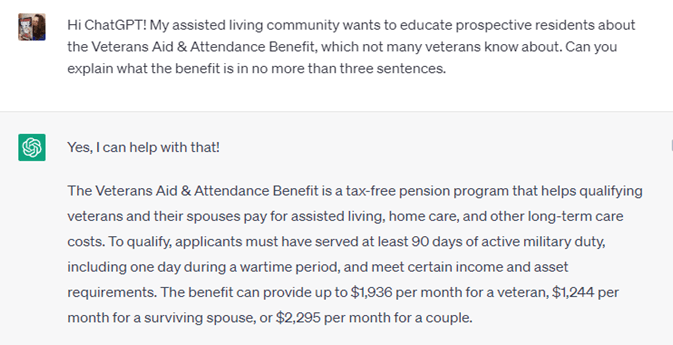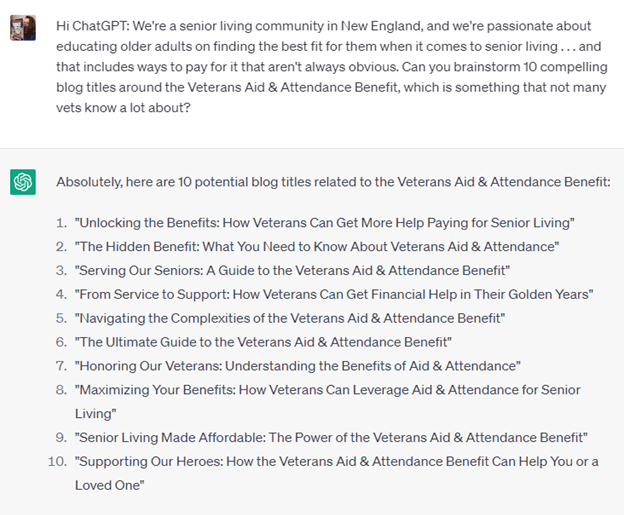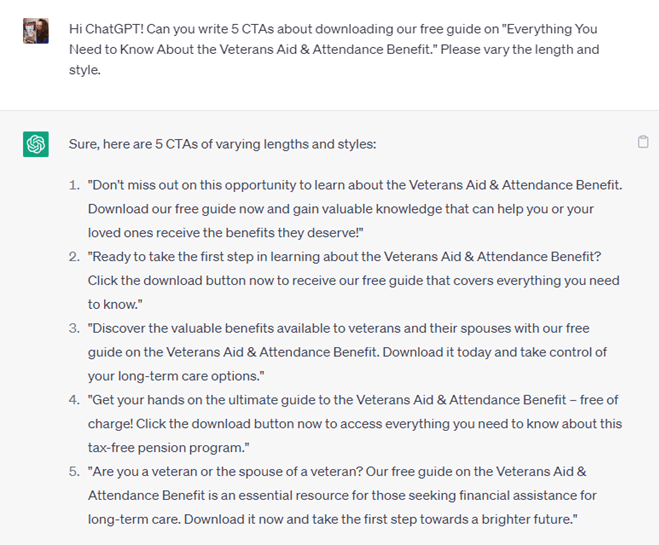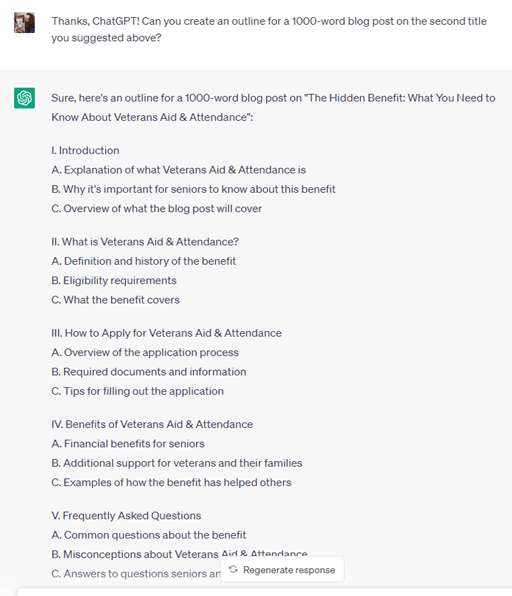ChatGPT: What to Know for Senior Living Marketing
You’ve probably heard people buzzing about ChatGPT. Its emergence has dominated headlines (it’s the fastest-growing app of all time), spurred countless debates, and worried everyone from teachers to writers to editors to ethicists to conspiracy theorists.
But what exactly is ChatGPT? And how can it be used to support your senior living marketing efforts?
Below, we’re going to answer those questions and more:
- What is ChatGPT?
- What sort of content can ChatGPT produce?
- Are there any issues with ChatGPT-generated content?
- Should you use ChatGPT for your senior living marketing?
Let’s get to it.
What is ChatGPT?
ChatGPT is a free artificial intelligence (AI) chatbot. It was released in November 2022 by OpenAI. ChatGPT stands for “Chat-based Generative Pre-trained Transformer,” which is a mouthful.
Also, what the heck does that even mean?
Simply put, ChatGPT delivers text-based responses to your “prompts.” A prompt is a question or a request, such as “Write a 600-word blog post about the benefits of senior living.” ChatGPT produces its responses astonishingly fast—and the responses sound remarkably human.
ChatGPT is “trained” on massive amounts of text data. From this data, it has learned how to mimic human conversations.
It’s worth mentioning that ChatGPT isn’t the only AI game in town. Here’s a list of 30 ChatGPT alternatives (free and paid). We’re focusing on ChatGPT because everyone is talking about it.
What sort of content can ChatGPT produce?
You can prompt ChatGPT to create various content, like a well-reasoned essay about Romeo & Juliet, a poem on first love, or an explanation of the Veterans Aid & Attendance benefit.
See the screenshot below, which includes our prompt and ChatGPT’s response.

ChatGPT wrote the above in a matter of seconds.
Impressive, right? Well, yes and no.
The above might sound convincing, but ChatGPT’s answer is outdated. The 2023 rate for a surviving spouse is now $1,432, not $1,244. The other numbers are also incorrect.
The above example highlights two of the most significant issues with ChatGPT to date:
- ChatGPT is “trained” only through 2021.
- ChatGPT makes LOTs of mistakes.
ChatGPT got the details wrong about the Veterans Aid & Attendance benefit because of its training—it has no “knowledge” of anything after 2021, so it doesn’t know about the updated rates for 2023.
But here’s the thing: ChatGPT also makes plenty of mistakes on things it should know.
Many people have written about this issue. Here are some excellent articles to check out if you want to dive deeper.
- If ChatGPT doesn’t get a better grasp of facts, nothing else matters – Fast Company
- ChatGPT will keep ‘hallucinating’ wrong answers for years to come and won’t take off until it’s on your cellphone, Morgan Stanley says – Business Insider
- The ChatGPT chatbot from OpenAI is amazing, creative, and totally wrong – Mashable
Are there any other issues with ChatGPT-generated content?
Yes! If the lack of accuracy isn’t enough to give you pause, then the following issues might:
- ChatGPT has trouble producing long content. It can lose the “thread” of a discussion once it hits 800 or so words.
- ChatGPT content often sounds stilted. It’s trying to mimic humans, but it’s not human. While the content is grammatically correct, it can still sound wooden. (And good luck trying to get it to capture your brand voice.)
- ChatGPT-generated content could have serious SEO implications. We’ll address this in a subsequent blog post, but if you use ChatGPT to create tons of content to manipulate your site’s rankings in Google, we have two words for you: keyword stuffing. (In other words, Google doesn’t like being manipulated, and it’s only a matter of time before it updates its algorithm accordingly.)
Should you use ChatGPT for your senior living marketing efforts, like content creation?
ChatGPT shouldn’t replace your current process for creating high-quality, original, long-form content. The issues with originality, accuracy, tone, and potential SEO implications outweigh any benefits.
But ChatGPT does have potential in other areas:
Use it for brainstorming.
Brainstorming might be the best use for ChatGPT in senior living marketing. Give ChatGPT a keyword phrase and ask it to brainstorm ten potential blog post titles. Then, choose the title you like best and hand it off to a writer.
Below is a screenshot of this idea in action.

Use it to create outlines.
A keyword-rich blog title and solid outline can help make a writer’s job go much faster. Having ChatGPT do the heavy lifting with the outline is another smart way to use this tool.
See the screenshot below. You’d still want to review and revise the outline. But ChatGPT typically delivers a solid structure that you or your writer could easily work with.
Use it for short-form content (but always review and revise).
We asked ChatGPT to write five calls to action for a guide about the Veterans Aid & Attendance benefit. Some might work better as social media posts. All would need to be revised for style and voice.

Bottom line: Be careful how you use ChatGPT for your senior living marketing.
ChatGPT is one tool, not the only tool. While it might be helpful with brainstorming and generating outlines, you shouldn’t use it to generate long-form content. Stick to humans for that.
Need help developing an effective content strategy for your senior living community? Get in touch, and let’s chat!





